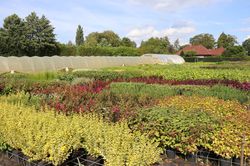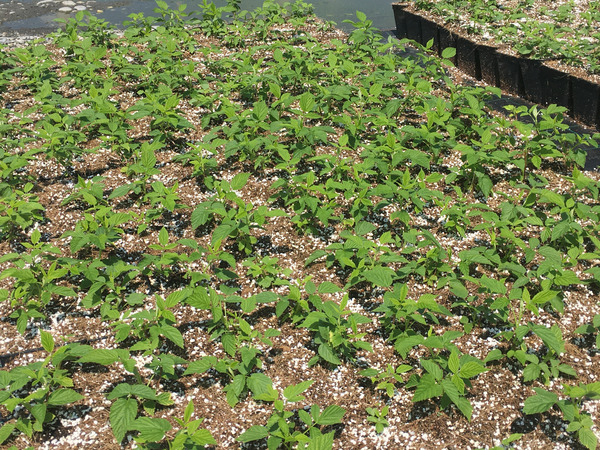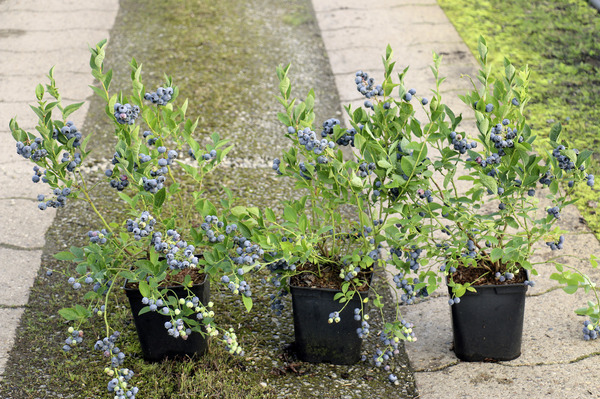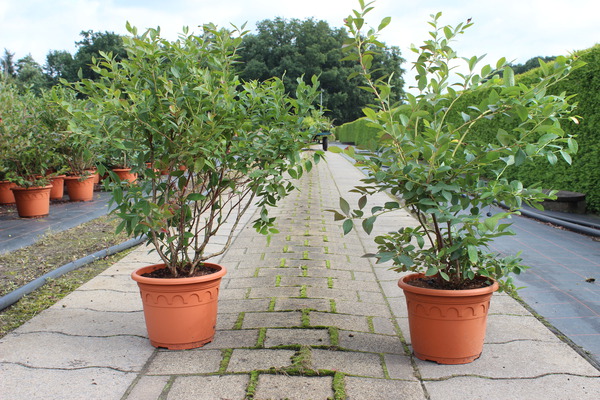 The 2 to 3 litre pot, tall and usually square, has become the standard in berry plant production. If you wander through the garden centres in the spring and analyse the offers with a gardener's eye, all you see is always the same: almost the same pot, with a slightly different but always large label, nota bene with as little information as possible. It is a well-known fact that customers cannot read. At least that's what our advertising consultants seem to think. Garden centres are no better. I recently saw almost identical plants from four suppliers from two countries in a garden centre in France; the uniform picture has spread internationally. Is that the way it should be? Aren't we constantly missing out on market opportunities, just when the market is returning to normal after the pandemic boom? Markus Kobelt from Lubera® asks himself (and us) this question in the following article.
The 2 to 3 litre pot, tall and usually square, has become the standard in berry plant production. If you wander through the garden centres in the spring and analyse the offers with a gardener's eye, all you see is always the same: almost the same pot, with a slightly different but always large label, nota bene with as little information as possible. It is a well-known fact that customers cannot read. At least that's what our advertising consultants seem to think. Garden centres are no better. I recently saw almost identical plants from four suppliers from two countries in a garden centre in France; the uniform picture has spread internationally. Is that the way it should be? Aren't we constantly missing out on market opportunities, just when the market is returning to normal after the pandemic boom? Markus Kobelt from Lubera® asks himself (and us) this question in the following article.
Industrial logic controls the supply
This supply structure (everything in 2 litre pots, simple, practical, square, good) makes sense for the production company: productivity is highest per unit of area; a 5 litre pot can hardly be made so expensive that it would achieve the same productivity per unit of area. The standardisation also makes many other things easier: the cultivation, possibly the pruning, the purchase of soil and pots. These advantages coincide with those of the reseller, the garden centre: if the berries are also sold at a single price, as is so often the case, 10-20 items ultimately technically shrink into a single item. Of course, you can go into more detail, but you will treat the berry pot as a single item – and thus simplify purchasing, the supply inventory and marketing. But does this also maximise sales?
Where are the customers’ wishes?
Where are the customers, whom we serve so gladly and whose wishes we read so diligently from their lips? Is the berry really a product for them? And is it in our interest that they treat the berry as an article, simply taking one of the three or five berries and planting it somewhere, individually or together, indiscriminately. Are the customers as stupid and clueless and as lacking in knowledge as the labels often make them out to be? When I see the questions we answer every day at Lubera, I'm not so sure.
What do the customers do with a raspberry, and what do they do with a blueberry?
For the customers, raspberries on the one hand and, for example, blueberries on the other hand have completely different framework conditions and also conclusions. The raspberry is still planted in numbers…six raspberries, twelve raspberries. Such shopping basket contents are very common online, especially when the customer is told what it takes for a row of raspberries: with six raspberries, just two metres are fully planted. This then results in 3-6 kg of raspberries. If half are eaten fresh, this is enough for a few packs in the freezer or for a few jars of mother's or father's homemade jam.

Picture: Raspberry plants in a 1.3 litre pot, it shouldn't be much bigger - and with these three plants you can plant just one metre, to feed a family of four it should be at least two metres.
In contrast, very few customers buy six blueberries. It is true that blueberries have successfully improved their reputation; they are omnipresent, especially in supermarkets, and are offered there more often than raspberries. Nevertheless, the difficulties with pot cultivation and the demands on acidic soil (a bog bed is necessary) lead to a much more restrained use of blueberries in the garden. According to our figures, about four times more raspberries are sold than blueberries. In comparison with currants (in all colours) or with specialities such as firstberries (blue honeyberries) or Amelanchier, the ratio becomes even more one-sided. Is it then really right to present the consumer with a uniform standard berry?
What is the longer-term consequence of unification?
The longer-term consequence of this factually incorrect standardisation can be seen in two tendencies:
Firstly, because we offer them in too large pots and tend to offer them at a rather high price, we do not sell as many raspberries as we could. We virtually educate the garden consumer not to make distinctions between berries. The lack of information (see also my somewhat nasty remarks about labels) just has consequences at some point. It is also striking that now, after the COVID-19 pandemic, the quantity correction is much stronger for raspberries than for the other species. It is also simply impractical to lug twenty 2-litre or even 3-litre pots home to plant a row of raspberries. Here it would be better to be able to buy a young plant than an oversized one. For there is still a crucial difference between the raspberry and the other bush berries: while the bush berries from the blueberry to the saskatoon berry build up a stable perennial plant body and accordingly a larger plant also yields much more quickly, the raspberry limits its above-ground plant life to one year (autumn raspberries) and two years for summer raspberries (of course to then also renew themselves continuously). Due to this fact, larger plants have almost no advantage over a smaller plant in raspberries; in terms of growing success, the young and small plants usually have the edge.

Picture: relatively small raspberry plants in a 12 cm pot - such young and fresh plants grow well in the garden and continue to grow immediately.
Secondly: we are giving away size potential and above all price potential in bush berries from blueberries to currants. Now, one could argue that we sell more plants of the more specialised berry species. Maybe this is the case from time to time, but I argue that we are missing out on much more up-grading potential (plant size and especially price) in these fruit species than we are gaining in volume. Because in the case of bush berries, a clear and obvious advantage shows up almost linearly with larger plants: a more and faster yield – and exactly this advantage can and could also be sold. In addition, the willingness to pay is fundamentally much greater for such niche products.
To do: downgrade raspberries, upgrade bush berries
What exactly should be done now? The conclusions follow straight from my argumentation:
Downgrade raspberries, move more towards strawberries, at best sell more in parallel with strawberries to strengthen the quantity and the classic use in rows/beds. Raspberries can easily be produced in a 12 cm pot or 1 litre pot. And why not offer units of six or four? A unit of six would cover exactly the needs for a 150-200 cm raspberry row and guarantee a long-term yield of 3-6 kg per year. The price doesn't have to drop into the ground for this, even if the pot gets much smaller, down to an 8 cm unit in a 6-pack: in the end, the grower achieves the same goal with the small young plant as with the larger finished plant, which nevertheless has no advantages, as it hardly yields immediately.

Picture: Raspberries in a 1.3 litre pot - quite small for berries, but rather a large size for raspberries.
Upgrade all other bush berries: I deliberately mean this upgrading in two ways: on the one hand, 3-15 litre plants are to be tested and brought to market. Here, a larger plant has the advantage that it is really ready, immediately yielding a full crop. A large blueberry in a 15 litre or 10 litre pot produces the same yield as a young plant in a 2 litre pot after three or four years! Money replaces time. Normally consumers are willing to pay for it. But only if they are made aware of the benefits.

Picture: Blueberries in a 5 litre container - Why not define this size as standard?

Picture: large and strong blueberry plants in a 15-litre container - such a plant produces almost a full yield for the end customer.
Of course, I understand that this proposed approach is ultimately more complicated than the one-size-fits-all berry. Nevertheless, even with this new differentiation strategy between raspberries and the rest of the bush berries, it would certainly be possible to find profitable and at the same time customer-friendly forms of supply that would please not only the customer but also the plant producer and the trader.
The disadvantages of uniformity
Back to my experience this spring in France: one garden centre, four suppliers with almost congruent assortments and the same impression. Almost the only difference is due to the earlier or later delivery date, which then has an influence on the quality of the many plants still standing around... And yes: as already mentioned, the labels are all meaningless. In any case, it would amount to a real feat to distribute even a little information on such large plastic surfaces.
Setting the irony aside, the problem with this standardisation is that the productivity gains in sales and production are accompanied by a huge loss of difference in the eyes of the customer: for the hobby gardeners, everything is the same, it doesn't matter what they buy either. Anyone standing in front of these full tables of 2-litre berries is very quickly struck with plant blindness; they can no longer see the individual tree due to the entire forest, so to speak. And let's not forget: from the point of view of the reseller, the wholesale customer, every producer is uniform, easily replaceable, and only the prices are worth discussing.
The only thing that helps against this is more differentiation: in plant sizes, in pricing, in sales arguments. After all, we know that there is a big difference between a raspberry and a blueberry. Don't we?
